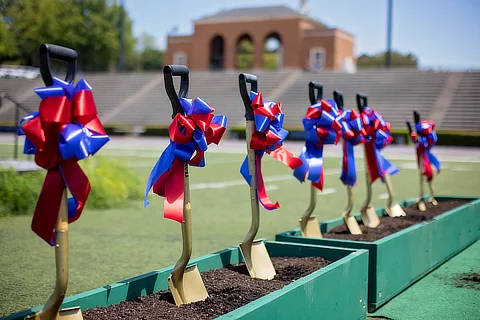
Samford University’s new Campus Recreation, Wellness and Athletic Complex is a first of its kind project in many ways, including one that demonstrates the university’s commitment to sustainability. In constructing the historic facility, the university is pursuing Leadership in Energy and Environmental Design (LEED) certification, a globally recognized symbol of sustainability achievement, energy efficiency, and environmental stewardship.
“It was important to reach farther to gain the certification to let our community know the importance of the process, outcome, and Samford’s push towards a more sustainable campus,” said Jeff Poleshek, Assistant Vice President of Operations, Planning and Construction.
Among its many features, the new complex will include open vegetated spaces instead of traditional roofing and parking materials, designated exterior fixtures that will reduce light pollution, low flow plumbing fixtures, and enhanced indoor air mechanical systems and controls that are more efficient. It will be among the first set of buildings on campus that have earned LEED certification.
In addition, construction on new residence halls announced in the Samford Horizons campus master plan is underway using similar concepts – from energy saving equipment to “green” waste management practices.
These measures for new campus construction are just the next step in the university’s infrastructure improvement plan which began five years ago through a partnership with Johnson Controls Inc., a global leader in the manufacture and promotion of energy efficient technologies. Since then, the university has rebuilt its chill water plant, changed almost all lighting campuswide to LED, replaced plumbing fixtures to reduce water consumption and installed more than 1000 energy efficient windows.
The university also has ongoing initiatives to plant new trees and vegetation across the campus. Samford is recognized as a Tree Campus - Higher Education by the Arbor Day Foundation for its work promoting healthy trees and engaging in the spirit of conservation. To obtain this distinction, Samford met the five core standards for effective campus forest management, including establishment of a tree advisory committee, evidence of a campus tree care plan, dedicated annual expenditures for its campus tree program, an Arbor Day observance and the sponsorship of student service-learning projects. Furthermore, when trees are removed due to construction, the wood is repurposed and integrated into the new facilities.
University leaders are committed to continuing all of these efforts as the Samford Horizons plan is implemented over the coming years.
“One of Samford’s core values is stewardship of all resources. We are caring of God’s creation, and it’s our responsibility to sustain and restore things within it,” said Poleshek.
